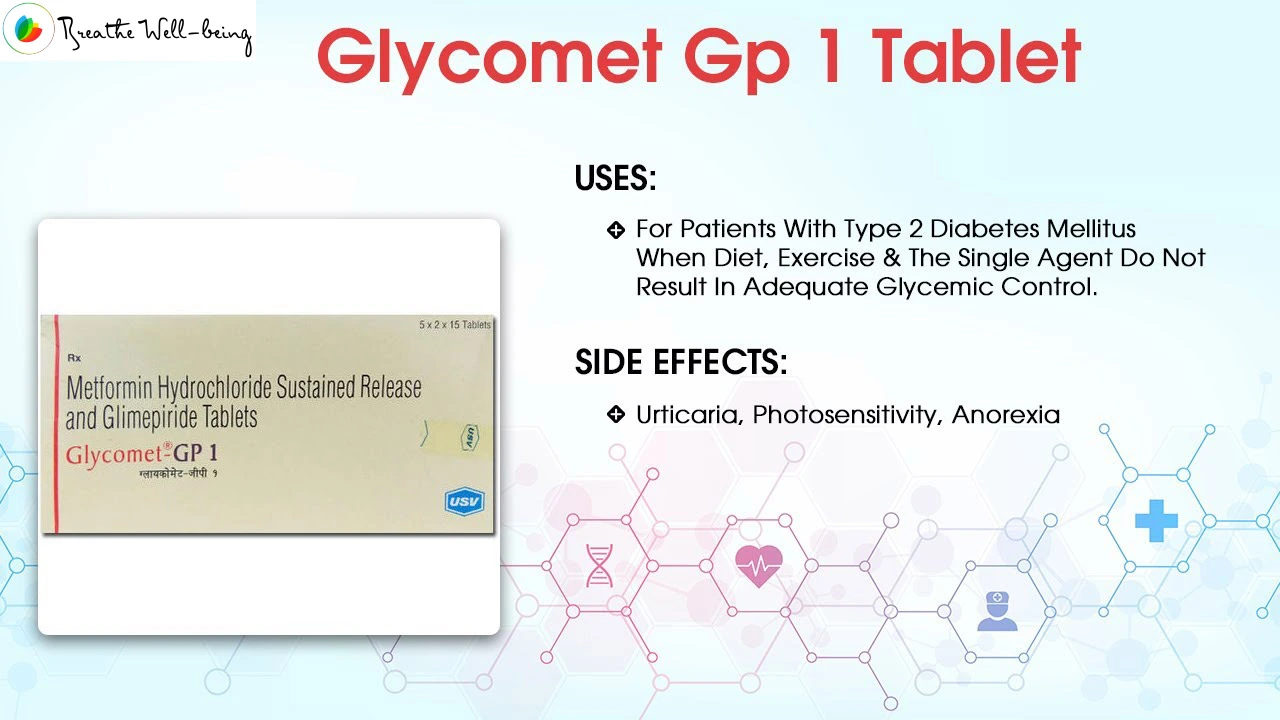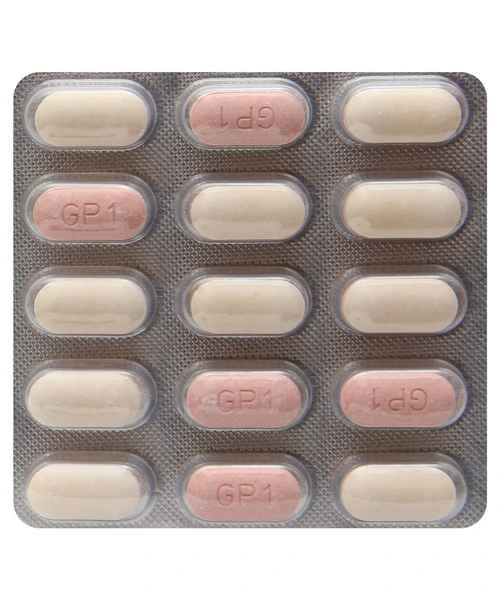Last updated on March 2nd, 2022
Glycomet GP 1 Tablet is a mixture of Glimepiride and Metformin, two anti-diabetic medicines. The sulfonylurea glimepiride works by raising the amount of insulin produced by the pancreas. Metformin, a ‘biguanide,’ works by decreasing glucose synthesis in the liver, slowing glucose absorption in the intestines, and enhancing the body’s insulin response. In a nutshell, the two medications work together to keep blood glucose levels from climbing too high, allowing you to maintain control of your diabetes.
Type 2 diabetes is a long-term or chronic disease that alters how your body processes glucose. Type 2 diabetes patients either do not create enough insulin or produce insulin that cannot accomplish its role in the body (insulin resistance). The blood glucose level increases as a result, and symptoms such as frequent urination, increased thirst, and hunger emerge. It can cause significant complications such as skin infection, retinopathy (eye difficulties), neuropathy (nerve damage), diabetic foot (foot ulcer), nephropathy (kidney disease), high blood pressure, and even stroke.
The two medicines in Glycomet GP 1 Tablet work together to keep your blood sugar levels in balance through the methods mentioned above. To highlight the many disabling side effects of diabetes, proper blood sugar control is very crucial. When combined with healthy lifestyle changes such as weight loss, regular exercise, and a nutritious diet, glycomet gp1 Tablet produces the best results.
To avoid an upset stomach, you should take Glycomet-GP 1 Tablet with food. For the most outstanding results, you should take the glimepiride gp1 Tablet simultaneously each day. Your doctor will determine the appropriate dose for you, and it may alter over time depending on your condition. Glycomet-GP 1 Tablet common side effect is hypoglycemia (low blood glucose levels), characterized by sweating, dizziness, palpitations, dry mouth, hunger pangs, skin, etc. So, to avoid hypoglycemia, you should not miss meals and should carry some form of sugar along with you. Other side effects include nausea, diarrhea, taste change, headache, stomach pain, upper respiratory symptoms.
Glycomet-GP 1 Tablet should not be stopped without visiting your doctor, even if you feel better. Sugar levels fluctuate. When you stop taking glycomet gp1 tablet suddenly, your blood sugar levels may rise, increasing your risk of vision loss (retinopathy), kidney damage (nephropathy), and nerve damage (neuropathy).
If you have type-1 diabetes, significant kidney illness, or liver disease, you should not use Glycomet-GP 1 Tablet. If you have a cardiac condition, are pregnant or planning to become pregnant, or are breastfeeding, please tell your doctor.
Also Read: Galvus Met 50/500 MG Tablet Uses, Side Effects, Dosage & Interactions
Uses of Glycomet GP 1 Tablet
Medicinal Benefits
Glycomet GP 1 Tablet aids in blood sugar regulation without causing weight gain. It is also cardioprotective, meaning it protects the heart from future difficulties. Glycomet-GP 1 Tablet also aids in the prevention of significant diabetes consequences such as diabetic nephropathy also known as kidney damage, diabetic retinopathy also known as loss of vision, diabetic neuropathy is known as loss of sensation in the hands and feet and even amputation! The gp1 tablet also aids in the prevention of heart attacks and strokes. Because it combines two medications eliminates the need for many pills, making it easier to remember to take them.
Directions for Use
Follow your doctor’s advice and take glycomet gp1 dosage. It is recommended to take with meals to minimize stomach upset. Swallow them whole with a glass of water. Do not chew or crush. If you forget to take Glycomet-GP 1 tablet, do not take it twice as it can lower your blood sugar (hypoglycemia) and be fatal.
Also Read: Janumet 50 mg / 500 mg Tablet to Control High Blood Sugar Levels
Side Effects of Glycomet GP 1 Tablet
Summary
Many of the glycomet gp1 side effects do not require medical attention and gradually disappear over time. However, if the side effects persist, consult your doctor. Common side effects of Glycomet-GP 1 Tablet are hypoglycemia (hypoglycemia), characterized by dizziness, sweating, palpitations, hunger, band dry mouth and skin. Some people experience taste changes, nausea, diarrhea, and abdominal pain. , Gas, headache, upper respiratory tract symptoms, rash, etc. Not everyone needs to experience the above side effects. Talk to your doctor if you feel uncomfortable.
Glycomet GP 1 Tablet Precautions and Warning
Drug Warnings
Some people with diabetes who take Glycomet-GP 1 tablets may develop a severe condition called lactic acidosis. With lactic acidosis, too much lactic acid has built up in the blood. Therefore, the liver and kidneys must function properly to remove excess lactic acid from the blood. Do not take metformin if you have kidney disease, as measured by a blood test. Glycomet-GP 1 Tablet can lower vitamin B12 levels, so be sure to get a blood test and vitamin blood test every year. When metformin is used in combination with insulin, blood sugar levels can drop significantly. Therefore, doctors can reduce the insulin dose.
Alcohol
Glycomet-GP 1 Tablet should not be taken until prescribed if you are taking alcohol. Taking Glycomet-GP 1 Tablet with alcohol can cause hypoglycemia and lead to a rare but life-threatening ailment known as Lactic Acidosis. So, keep your doctor informed if you drink alcohol.
Pregnancy
GP-1 tablet of Glycomet is not recommended during pregnancy. However, your doctor may prescribe it during pregnancy if you think the benefits outweigh the risks. Do not take the Glycomet-GP1 tablet without your doctor’s advice.
Breastfeeding
The name is not recommended during breastfeeding. However, your doctor may prescribe it for you during breastfeeding if they feel that the benefit to you outweighs the risk. You should not take Glycomet gp 1 Tablet without a doctor’s advice.
Driving
Glycomet gp1 Tablet may cause hypoglycemia (low blood sugar levels), whose symptoms include unusual sleepiness, shivering, palpitations, sweating, etc. This may affect your ability to drive. Use caution while going or doing anything that requires concentration.
Liver
If you have or have a history or evidence of any liver-related diseases, please consult the doctor before taking medicine. The dose may have to be adjusted by your doctor.
Kidney
If you have or have a history or evidence of any kidney-related diseases, please consult the doctor before taking glycomet g1 medicine. The dose may have to be adjusted by your doctor.
Also Read: Glycomet GP2 Tablet Uses, Side Effects, and Safety Advice
Diet & Lifestyle Advice
- Put the starches in half a plate, protein in a quarter, and whole grains in a quarter.
- Eat regularly. Do not take long intervals between meals and snacks.
- Check your blood sugar regularly, significantly if it fluctuates.
- Get at least 150 minutes of moderate-intensity physical activity or 1 hour and 15 minutes of high-intensity exercise each week.
- Gradually lose weight to achieve a healthy body mass index (18.5 to 24.9).
- Replace foods that contain refined carbohydrates with whole foods and increase your intake of fruits, vegetables, and other foods high in fiber.
- Reduces the consumption of saturated fats (or hidden fats) in foods such as chips, French fries, cakes, cookies, and samosas. Choose oil that contains omega-three fatty acids that you cook daily. You can use palm oil, rice bran oil, peanut oil, rice bran oil, and safflower oil for fried foods.
- Don’t worry; it can raise your blood sugar. You can use stress management techniques such as mindfulness to control stress-related changes in blood sugar.
- Choose low-fat dairy products (low-fat yogurt, skimmed milk, cheese, etc.).
- Keep your blood pressure as normal as possible (140/90). It reduces the risk of cardiovascular disease in people with diabetes.
Special Advice
Summary
Even if you think your blood sugar levels are under control, keep taking the medication. Do not double the dose if you miss a dosage; instead, get guidance from your treating physician.
When using glycomet gp1 1mg medication, eat small, regular meals and avoid fasting for long periods. Hypoglycemia can cause sweat, dizziness, palpitations, shivering, severe thirst, dry mouth, dry skin, frequent urination, and other symptoms. If you encounter any of the symptoms listed above, eat 5-6 candies, three glucose biscuits, or three teaspoons of honey/sugar right away and contact your doctor. Make sure you have these on you at all times, especially if you’re going on a lengthy trip.
Before your doctor prescribes this prescription, make sure your doctor is aware of any underlying illnesses you may have, such as kidney or liver disease, a previous heart attack, or alcohol consumption.
While taking this medication, avoid drinking alcohol since it raises the risk of hypoglycemia (low blood sugar, which can be fatal in some situations) and lactic acidosis (when the lactic acid increases in the body, which impacts the functioning of various organs in the body).
Quit smoking and eat fewer carbohydrate-rich foods like potatoes, rice, mangoes, bread, sugar, etc.
Remember that the most crucial step in regulating blood sugar levels is to change your lifestyle.
Also Read: Normal sugar level before breakfast
FAQs:
How to store Glycomet-GP 1?
You must Store it in a dry and cool place away from sunlight.
What are the possible side effects of Glycomet-GP 1 Tablet PR?
The use of Glycomet-GP 1 Tablet PR is associated with common side effects such as hypoglycemia (hypoglycemia), taste disturbance, nausea, abdominal pain, diarrhea, headache, and upper respiratory tract infections. Its use can also cause serious but rare side effects such as lactic acidosis. Long-term use can also lead to a deficiency of vitamin B12.
What is Glycomet-GP 1 Tablet PR?
Glycomet-GP 1 Tablet PR is a combination of two medicines, glimepiride and metformin. This medicine is used to treat type-2 diabetes (DM). Combined with a proper diet and regular physical activity, it improves blood sugar levels in adults. Glimepiride lowers blood sugar by increasing the release of insulin from the pancreas. Metformin works by reducing the production of glucose in the liver and improving insulin sensitivity. This combination is not indicated for the treatment of type 1 diabetes.
Can lactic acidosis be caused by taking Glycomet-GP 1 Tablet PR?
Lactic acidosis can be caused by taking Glycomet-GP 1 Tablet PR. It is a medical emergency caused by elevated lactic acid levels in the blood. MALA is another name for it (Metformin-associated lactic acidosis). Because it is a rare adverse effect associated with metformin treatment, it is considered dangerous for patients with underlying kidney disease, the elderly, or consuming high amounts of alcohol. Muscle discomfort or weakness, dizziness, exhaustion, a sense of cold in the arms and legs, difficulty breathing, nausea, vomiting, stomach pain, or a sluggish heart rate are all symptoms of lactic acidosis. If one has these symptoms, they should stop taking Glycomet-GP 1 Tablet PR and consult their doctor immediately.
What are the recommended storage conditions for Glycomet-GP 1 PR tablets?
Put this medicine in the container or package that contains it and close it tightly—store following the directions on the package or label. Discard any unused medicine. Be careful not to let children or pets eat it.
References:
- https://www.tabletwise.net/glycomet-gp-1-tablet
- https://www.genericure.in/glycomet-gp-1-tablet
- https://www.zotezo.com/in/medicines/glycomet-gp-1-tablet/
Last Updated on by Dr. Damanjit Duggal
Disclaimer
This site provides educational content; however, it is not a substitute for professional medical guidance. Readers should consult their healthcare professional for personalised guidance. We work hard to provide accurate and helpful information. Your well-being is important to us, and we value your feedback. To learn more, visit our editorial policy page for details on our content guidelines and the content creation process.

 English
English












